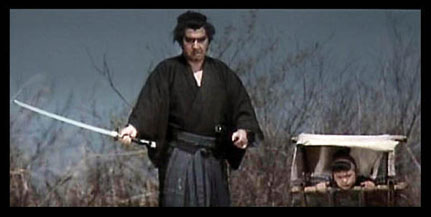|
|
Chapter Two: Shogun AssassinBy Brett BeachJune 10, 2010
What was done via the new dialogue and voiceover was a major oversimplification and overhauling of the plot so that the “story” could be kept confined to a single film with beginning, middle, and end, and the key action scenes from Sword of Vengeance (which is mostly setup for the series) could be lifted out and somehow incorporated. By an amusing irony then, the plot of Sword of Vengeance is so dense that to encapsulate here would almost require a separate column and the “plot” of Shogun Assassin is so minimal that it evaporates from one’s mind even in the act of viewing it. I found that watching the two films so close together tended to defeat any distinctions even further, especially since I was seeing the exact same footage in a different (but not drastically so) context. But the film’s masterstroke, intentional or not, is the narration. Some research on the Web - verified in more than one place - indicates that Gibran Evans, who was seven-years-old at the time, supplies the voice of Daigoro. Evans is the son of Jim Evans, a painter, illustrator, and graphic/web designer who also worked on concert and film posters including, yes, Shogun Assassin. So Houston and Weisman obviously didn’t venture far to find young Evans. The punch line is that - at least for this fan of voice over narration - Gibran’s work ranks among the best ever. I don’t know how much praise is warranted - if he was directed to read with a flat and consistent inflection or if he read all of his lines in 30 minutes in one studio session with no modulation but his voice matches perfectly with the sad passive eyes of Masahiro Tomikawa, and even now I can hear his tones sifting through my brain.
|

|
|
|

|
Sunday, May 5, 2024
© 2024 Box Office Prophets, a division of One Of Us, Inc.


